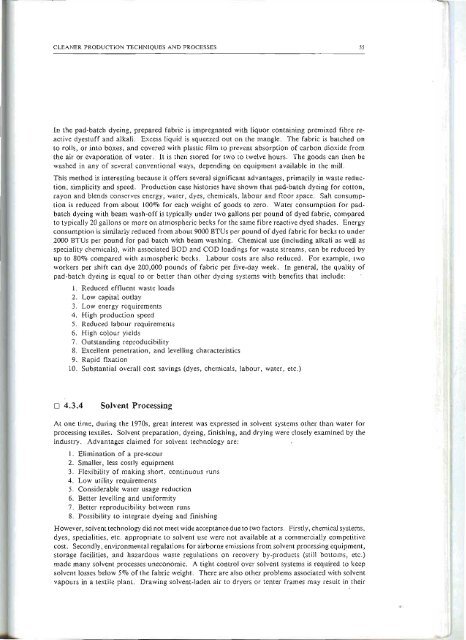Contributor, The Textile Industry and the Environment, UNEP
Contributor, The Textile Industry and the Environment, UNEP
Contributor, The Textile Industry and the Environment, UNEP
Create successful ePaper yourself
Turn your PDF publications into a flip-book with our unique Google optimized e-Paper software.
CLEANER PRODUCTION TECHNIQUES AND PROCESSES 55<br />
In <strong>the</strong> pad-batch dyeing, prepared fabric is impregnated with liquor containing premixed fibre reactive<br />
dyestuff <strong>and</strong> alkali. Excess liquid is squeezed out on <strong>the</strong> mangle. <strong>The</strong> fabric is batched on<br />
to rolls, or into boxes, <strong>and</strong> covered with plastic film to prevent absorption of carbon dioxide from<br />
<strong>the</strong> air or evaporation of water. It is <strong>the</strong>n stored for two to twelve hours. <strong>The</strong> goods can <strong>the</strong>n be<br />
washed in any of several conventional ways, depending on equipment available in <strong>the</strong> mill.<br />
This method is interesting because It offers several significant advantages, primarily in waste reduction,<br />
simplicity <strong>and</strong> speed. Production case histories have shown that pad-batch dyeing for cotton,<br />
rayon <strong>and</strong> blends conserves energy, water, dyes, chemicals, labour <strong>and</strong> floor space. Salt consumption<br />
is reduced from about 100070 for each weight of goods to zero. Water consumption for padbatch<br />
dyeing with beam wash-off is typically under two gallons per pound of dyed fabric, compared<br />
to typically 20 gallons or more on atmospheric becks for <strong>the</strong> same fibre reactive dyed shades. Energy<br />
consumption is similarly reduced from about 9000 BTUs per pound of dyed fabric for becks to under<br />
2000 BTUs per pound for pad batch with beam washing. Chemical use (including alkali as well as<br />
speciality chemicals), with associated BOD <strong>and</strong> COD loadings for waste streams, can be reduced by<br />
up to 80

















